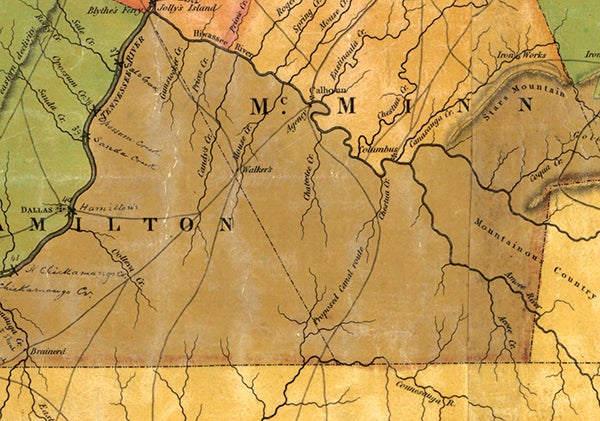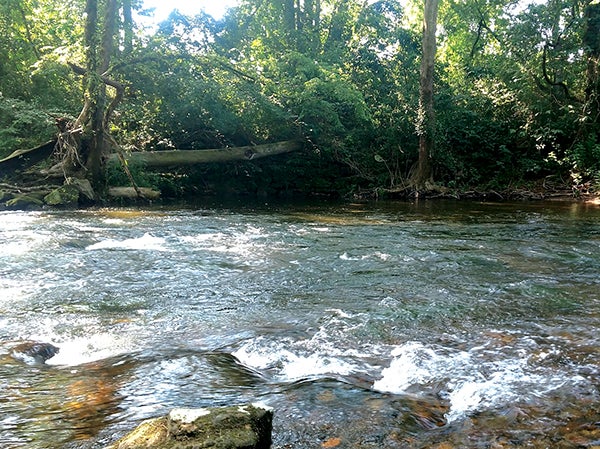Conasauga River nearly became important in Tennessee history
Published 10:29 am Tuesday, June 21, 2022
|
Getting your Trinity Audio player ready...
|
By BILL CAREY
As the only river in Tennessee that is not part of the Mississippi River system, the Conasauga River is the answer to an interesting trivia question. It nearly became a lot more than that.
The Conasauga flows west through Polk and Bradley counties, then turns south into Georgia. It later merges with the Oostanaula River, the Coosa River, the Alabama River, and — eventually — into the Gulf of Mexico. In fact, the Conasauga River’s odd geographic flow made the river quite alluring in the early 1800s.
Before man-made dams, there were serious barriers to navigation on the Tennessee River. Downstream from present-day Chattanooga there were rapids, shoals and currents with names such as the Suck, the Frying Pan and the Boiling Pot. A hundred miles further downstream, there was an even more notorious series of barriers known as the Muscle Shoals. There, the river widened and got so shallow that boats would get stuck for weeks at a time. All of this may make the Tennessee River sound like a kayaker’s paradise. But rivermen of the nineteenth century didn’t see it that way.
East Tennessee merchants were constantly looking for an alternative to the long and dangerous trek down the Tennessee River, all the way to the Ohio River, the Mississippi River and New Orleans. In 1821, some keelboat operators began taking the Tennessee River downstream to the Hiwassee River, then the Hiwassee upstream to the Ocoee, then the Ocoee upstream to a point about five miles south of present-day Benton. Boats and cargo were then lifted onto wagons and dragged nine miles south, where they were lowered onto the Conasauga for the long journey to Mobile Bay.
The portage on the Ocoee side was operated by a Cherokee family named Hildebrand, while the portage at the Conasauga end was operated by a Cherokee family named McNair. Today you can still find a road named for the Hildebrand family on the north end of the route and the McNair family cemetery on the south end. The road between these two take-out points is known locally as the Old Federal Road.
For about a generation, products such as flour and whiskey were moved with regularity through
this route.
The portage was an interesting alternative, but not efficient enough from a commercial point of view. No sooner did it start becoming used than talk began of a canal connecting the Ocoee and Conasauga rivers.
Today the notion of this canal might seem farfetched. But the 1820s was America’s “canal era.” The 336-mile Erie Canal, connecting the Great Lakes to the Atlantic Ocean, was being built in the early 1820s, and many other less prominent canals were being developed as well. Commercial boats were much smaller then than they are now. And any canal would have made water navigation feasible through a series of locks.
In 1826, the Tennessee General Assembly granted a charter to the Hiwassee Canal Company, whose intent was the development of the canal. About that time, Tennessee Governor Joseph McMinn petitioned Congress to obtain the permission of the Cherokee Nation to build the canal. Had the Ocoee-Conasauga canal been built, Tennessee history might have turned out differently. East Tennessee might have grown a lot more prior to the Civil War. Bradley and Polk counties
might have larger cities today.
However, the canal was never built. One reason was President Andrew Jackson’s lack of enthusiasm for internal improvements subsidized by the federal government. But the main reason appears to have been the opposition of the Cherokee Nation. It was, after all, Cherokee land at the time. When asked to sell the land through which the canal would be dug, Cherokee chiefs rejected the notion outright.
“The representatives of this nation solemnly pledged themselves in General Council that they would never dispose of one foot more of land again,” said a document signed by 22 Cherokee chiefs (including John Ross) on October 11, 1827.
Today, the Ocoee is known for whitewater rafting. The Conasauga River is notable for the biodiversity of its fish, mussel, snail and crayfish populations.
In fact, the Conasauga has at least 10 species of fish and mussels which are listed as endangered and threatening — and many of them might be gone by now had they once connected the isolated Conasauga system to the Tennessee River system. So maybe it’s just as well that the Ocoee-Conasauga canal was never built.
Bill Carey is the founder of Tennessee History for Kids, a non-profit organization that helps teachers cover social studies.






